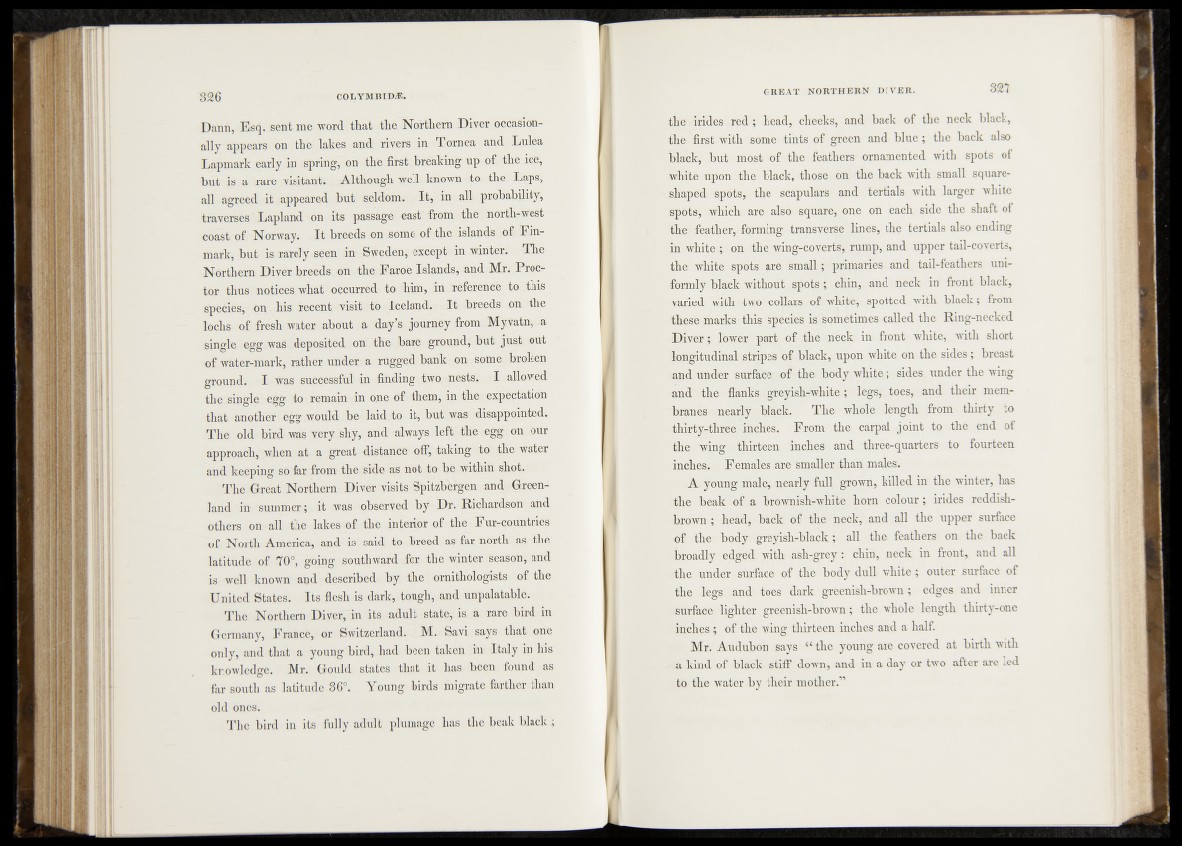
Dann, Esq. sent me word that the Northern Diveroccasioh-
a lly appears on the lakes and rivers in Tornea and/Lulea
Lapmark early in spring, on the first "breaking up of. thesiceS,
but is a rare visitant. Although well known to the Laps*
all agreed it appeared hut seldom, It, in all prohahilhjl
traverses'. Lapland on its passage east from the. nortliTWest -
coast of Norway. I t breeds on some ofvthe islands of Fin-
mark, but is rarely seen in-Sweden, except in winter. *Ehe
Northern Diver breeds. on the: Faroe Islands, and Mr. Procr
tor thus notices.what occurred to diim, in Teference>| k® ^this
species, on his recent visit-to-Iceland. Ik-breeds o n ’the
lochs of fresh water about a day's« journey from. Myyatn^a
single egg waS deposited on the bare ground^ but,Just out
of water-mark* rather under- a rugged bank on some broken
ground. I was. successful in finding two.virests,.; I ,allowed
the single egg -to; remain in one of them, in th e . expectation
that another egg would be laid .to it, but was disappointed.
The old bird was very shy, and always left “the egg on our
approach, when at a great distance off, taking, to. the water
and keeping so far from the side as not to- be within shot,
The Great Northern Diver visits Spitzb&gen and, Greenland
in summer; it was observed by1- Dr. Richardson and
others on all the lakes of the interior of the Fur-countries
of. North America, and is said to breed as far north as the
latitude of 70°, going southward for the winter season, and
is well known and described by the ornithologists of the
United States. Its flesh is dark, tough, and unpalatable.
The Northern Diver,“in its adult state, is a rare bird in
Germany, France, or Switzerland. M.. Savi says that one
only, and that a young bird, had been taken in Italy in his
knowledge. Mr. Gould states that it has been found as
far south as latitude 36?. Young birds migrate farther than
old ones.
The bird in its fully adult plumage has the beak black.;
the I irides red ; head, cheeks, and back of the neck black,
the; first with some tihts of green and b lu e ; the back also
black, but most, of the feathers ornamented with spots of
white upon the black, those on the back with small square-
shaped spotsj the scapulars and tertials with larger white
spots, which are also square, one on each side the shaft of
the feather, forming transverse lines, the tertials also ending
in white ;-on the wing-coverts, rump, and upper tail-coverts,
the/ white .spots are small; primaries and tail-feathers uniformly
black without spots ; chin, and neck in front black,
varied with two -collars of white, spotted with black; from
these marks this species is soihetimes called the Ring-necked
Diver; lower part of the neck in front white, with short
longitudinal stripes of black, upon white on the sides; breast
and under surface of the body white; sides under the wing
and the flanks greyish-white.; legs, toes, and their membranes
nearly black. The whole length from thirty to
thirty-three. Inches. From the carpal joint to the end of
the wing thirteen inches and three-quarters to fourteen
inches. Females are smaller than males.
A-young male, nearly full grown, killed in the winter, has
the beak of a brownish-white horn colour; irides reddish-
brown ; head, back of Ike neck, and all the upper surface
of the body greyish-black; all the feathers on the back
broadly edged with ash-grey: chin, neck in front, and all
the under surface of the body dull white; outer surface of
the legs and toes dark greenish-brown; edges and inner
surface lighter greenish-brown; the whole length thirty-one
inches^ of the wing thirteen inches and a half.
Mr. Audubon says “ the young are covered at birth with
a kind of black stiff down, and in a day or two after are led
to the water by their mother."”